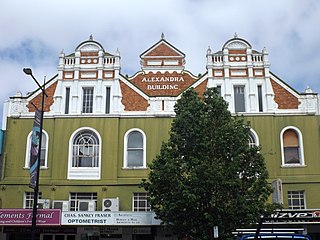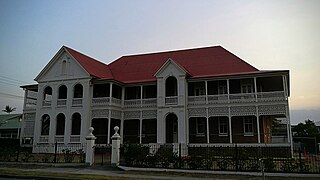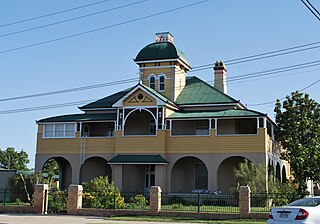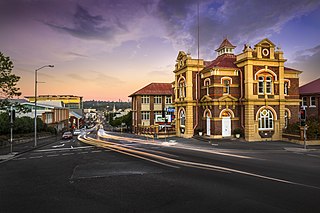
The Orient Hotel is a heritage-listed hotel at 560 Queen Street, Brisbane CBD, City of Brisbane, Queensland, Australia, on the corner of Ann Street. It was originally built as the Excelsior Hotel in 1875 and extended in 1884, both of which were designed by Brisbane architect Richard Gailey. It was added to the Queensland Heritage Register on 23 April 1999.

Alexandra Building is a heritage-listed commercial building at 451-455 Ruthven Street, Toowoomba, Queensland, Australia. It was designed by Toowoomba architect Henry James (Harry) Marks and built in 1902 by James Renwick. It was added to the Queensland Heritage Register on 16 October 2008.

Wickham Hotel is a heritage-listed hotel at 308 Wickham Street, Fortitude Valley, City of Brisbane, Queensland, Australia. Originally trading as the Oriental, it was designed by Richard Gailey and built in 1885 by Cussack & O'Keefe. It was added to the Queensland Heritage Register on 21 October 1992.

Prince Consort Hotel is a heritage-listed hotel at 230 Wickham Street, Fortitude Valley, City of Brisbane, Queensland, Australia. It was designed by Richard Gailey and built from 1887 to 1888 with later extensions. It was added to the Queensland Heritage Register on 21 October 1992. In 2014, it is trading as the Elephant Hotel.

Jubilee Hotel is a heritage-listed hotel at 464–468 St Pauls Terrace, Fortitude Valley, City of Brisbane, Queensland, Australia. It was designed by Richard Gailey and built from 1887 to 1888. It was added to the Queensland Heritage Register on 21 October 1992.

South Brisbane Library is a heritage-listed former library at 472 Stanley Street, South Brisbane, City of Brisbane, Queensland, Australia. It was designed by Francis Drummond Greville Stanley and built from 1881 to 1902 by W Macfarlane. It is also known as South Brisbane School of Arts, South Brisbane Mechanics Institute, South Brisbane Technical College, and South Brisbane Post & Telegraph Office. It was added to the Queensland Heritage Register on 21 October 1992. It now houses the Griffith University Film School, which forms part of the Queensland College of Art.

Beth-Eden is a heritage-listed villa at 85 Bank Road, Graceville, City of Brisbane, Queensland, Australia. It was designed by Richard Gailey and built from 1888 to 1910s. It is also known as Rakeevan and Verney. It was added to the Queensland Heritage Register on 21 October 1992.

The Phoenix Buildings are heritage-listed commercial buildings at 647 Stanley Street, Woolloongabba, City of Brisbane, Queensland, Australia. They were designed by Richard Gailey and built from 1889 to 1890 by James Rix. They were added to the Queensland Heritage Register on 24 May 1995.

Mount Carmel Convent is a heritage-listed former Roman Catholic convent at 199 Bay Terrace, Wynnum, City of Brisbane, Queensland, Australia. It was designed by Hall & Dods and built in 1915 by William Richard Juster. It was added to the Queensland Heritage Register on 27 August 1999.

Musgrave House is a heritage-listed sanatorium at 8 Allpass Parade, Shorncliffe, City of Brisbane, Queensland, Australia. It was designed by Richard Gailey and built from 1884 to 1920s. It is also known as Lady Musgrave Sanitorium for Sick Children. It was added to the Queensland Heritage Register on 22 October 1999.

Empire Hotel is a heritage-listed hotel at 339 Brunswick Street, Fortitude Valley, City of Brisbane, Queensland, Australia. It was designed by Richard Gailey and built in 1888 by Smith and Ball. It was renovated in 1925 to a design by Richard Gailey, Junior. It was further renovated in 1937 to incorporate apartments designed by Hall and Phillips. It was added to the Queensland Heritage Register on 21 October 1992.

Fortitude Valley State School is a heritage-listed former state school at 95 Brookes Street, Fortitude Valley, City of Brisbane, Queensland, Australia. It was designed by Benjamin Backhouse and built from 1867 to 1913. It is also known as State Emergency Services State Headquarters and former Fortitude Valley Boys School and former Fortitude Valley Girls and Infants School. It was added to the Queensland Heritage Register on 26 March 1999.

St Mary's Presbytery is a heritage-listed Roman Catholic presbytery of St Mary's Roman Catholic Church at 142 Palmerin Street, Warwick, Southern Downs Region, Queensland, Australia. It was designed by Wallace & Gibson and built from 1885 to 1887 by John McCulloch. It is also known as Father JJ Horan's private residence. It was added to the Queensland Heritage Register on 31 July 2008.

Queen Victoria Silver Jubilee Memorial Technical College is a heritage-listed technical college at 88 Limestone Street, Ipswich, City of Ipswich, Queensland, Australia. It was designed by architect George Brockwell Gill and built from 1897 to 1937. It is also known as Ipswich TAFE College and Ipswich Technical College. It was added to the Queensland Heritage Register on 21 October 1992.

The Bank of New South Wales is a heritage-listed former bank at 242 Mary Street, Gympie, Gympie Region, Queensland, Australia. It was designed by Richard Gailey and built from 1890 to 1891 by T. Kelly. It is also known as Widgee Shire Council Chambers, Coolooa Shire Council Chambers and Gympie Regional Council Chambers. It was added to the Queensland Heritage Register on 15 April 2011.

Maryborough School of Arts is a heritage-listed School of Arts building at 427 Kent Street, Maryborough, Fraser Coast Region, Queensland, Australia. It was designed by John Harry Grainger and built from 1887 to 1888 by Jacob & John Rooney. It is also known as Museum and Technical College and Recreation Club. It was added to the Queensland Heritage Register on 21 October 1992.

Bundaberg School of Arts is a heritage-listed former school of arts and now community centre at 184 Bourbong Street, Bundaberg Central, Bundaberg, Bundaberg Region, Queensland, Australia. It was designed by Anton Hettrich and built from 1888 to 1889. It was added to the Queensland Heritage Register on 21 October 1992.

Rockhampton Girls Grammar School is a heritage-listed private school at 155 Agnes Street, The Range, Rockhampton, Rockhampton Region, Queensland, Australia. It was designed by Edwin Morton Hockings and built in 1890 by Moir Cousins and Co. It was added to the Queensland Heritage Register on 20 October 2000.

Brisbane Grammar School Buildings are a heritage-listed group of private school buildings of Brisbane Grammar School, 24 Gregory Terrace, Spring Hill, City of Brisbane, Queensland, Australia. They were added to the Queensland Heritage Register on 21 August 1992.

Toowoomba Grammar School buildings are a heritage-listed pair of school buildings at Toowoomba Grammar School at 24-60 Margaret Street, East Toowoomba, Toowoomba, Toowoomba Region, Queensland, Australia. They were designed by Willoughby Powell and built from 1875 to 1940s. It was added to the Queensland Heritage Register on 21 October 1992.


























